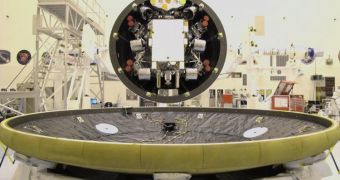With its launch date scheduled sometime between November 25 and December 18, the NASA Mars Science Laboratory (MSL) rover Curiosity is currently undergoing final preparations and tests. Yesterday, on October 5, the robot was mated with its aeroshell.
The latter is made up of the bottom heat shield, which will protect Curiosity during its steep-angle descent through the Martian atmosphere, and the back shell powered descent vehicle, which includes the Sky Crane delivery system and another protective fairing.
It helps to think of the rover as attached to a small platform featuring 8 jet nozzles. This is the Sky Crane, a mechanism developed specifically for placing the 1-ton, Mini Cooper-sized robot on Mars.
The system is attached directly to Curiosity. Together, they are placed on top of the heat shield, while the upper protective fairing comes on top. As it will descent through the Martian atmosphere, the heat shield will be the first to be discarded, after reentry heat dissipates.
The back shell – which also holds the parachute – will be separated as the rover and its delivery mechanism near the actual surface. After this second separation, the Sky Crane will fire its thrusters, leveling up and then dropping Curiosity to the surface via a cable.
Once the rover is safely down on Mars, the cable will separate, and a final thruster boost will push the lifting mechanism miles away, where it will crash. What technicians at the NASA Kennedy Space Center (KSC), in Florida, did yesterday was bring all four major components together.
According to current plans, the MSL is scheduled to land at Gale Crater sometime in August 2012. This location was selected because of the vast potential for scientific return it promises. A huge mountain lies at its center, which mission controllers plan to climb using the rover.
“After arrival, the Curiosity rover will investigate whether the landing region has had environmental conditions favorable for supporting microbial life and favorable for preserving clues about whether life existed,” researchers at the NASA Jet Propulsion Laboratory (JPL), in Pasadena, California, say
JPL manages the MSL project for the NASA Science Mission Directorate, in Washington, DC. The lab is a division of the California Institute of Technology (Caltech), which manages it for NASA. The MSL project took more than $2.5 billion to complete, and is the most complex Martian mission ever.

 14 DAY TRIAL //
14 DAY TRIAL //